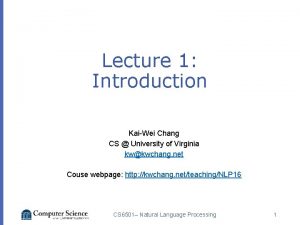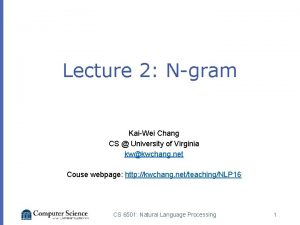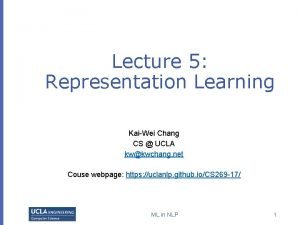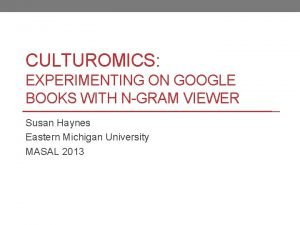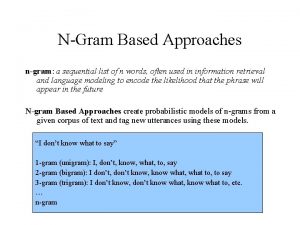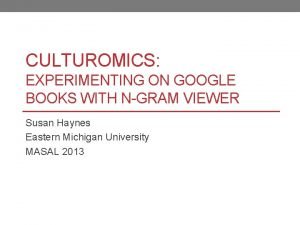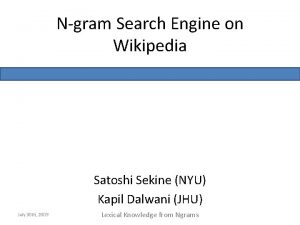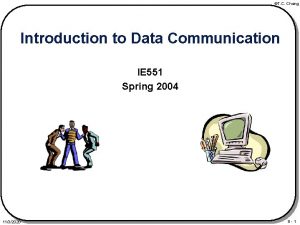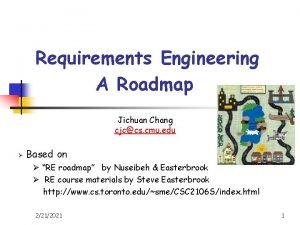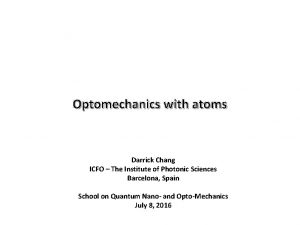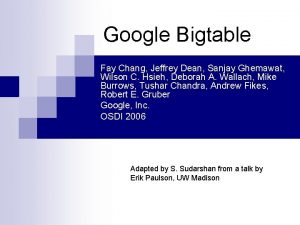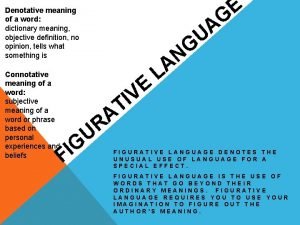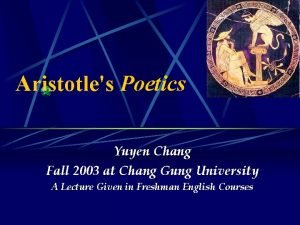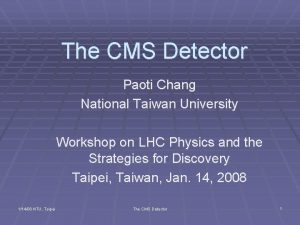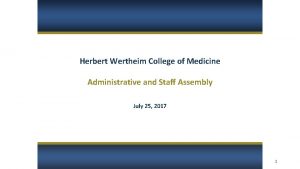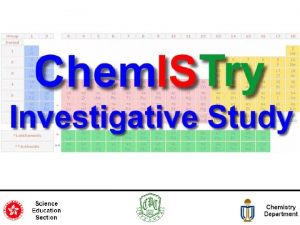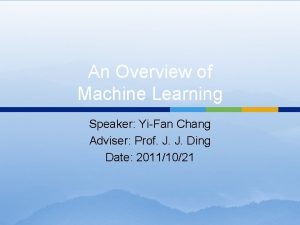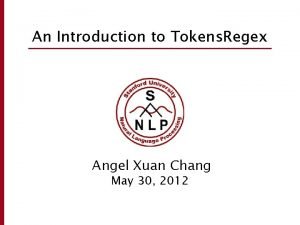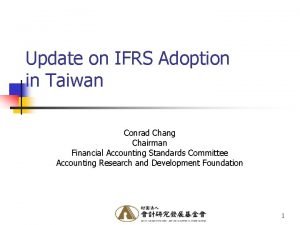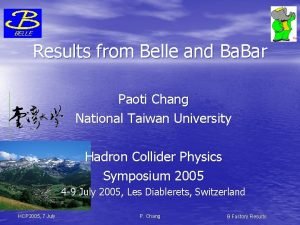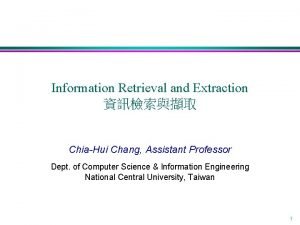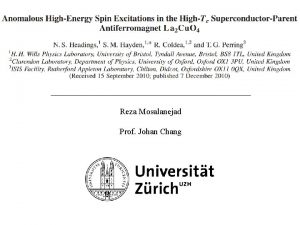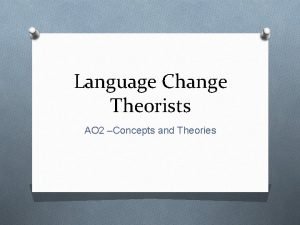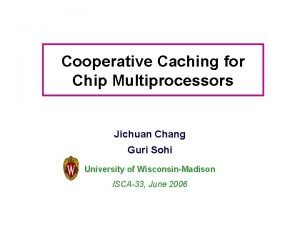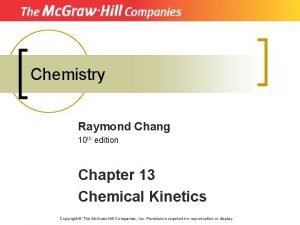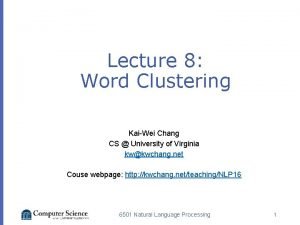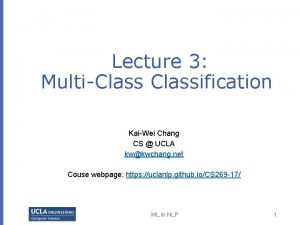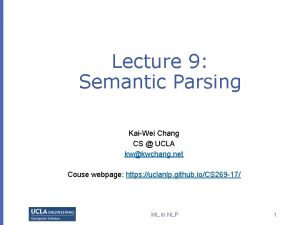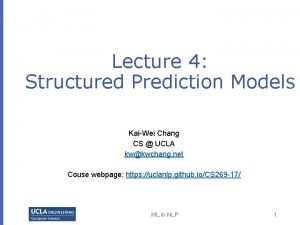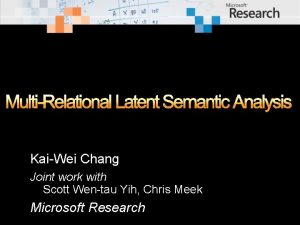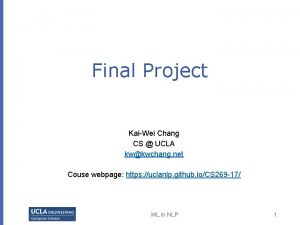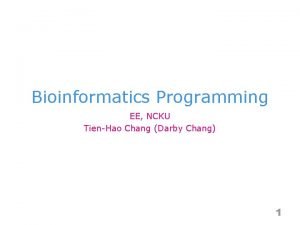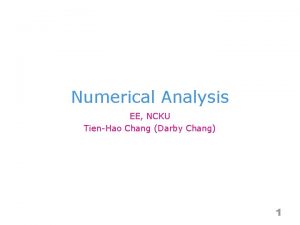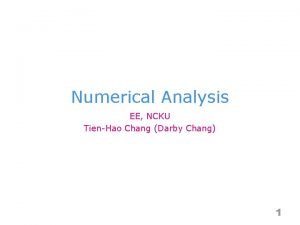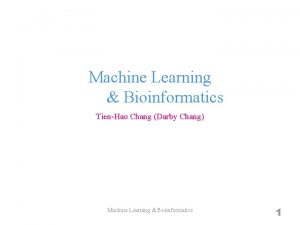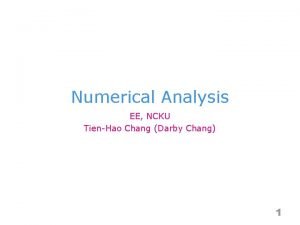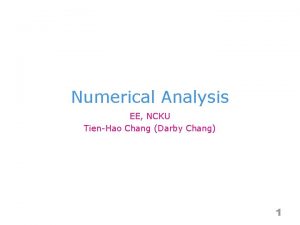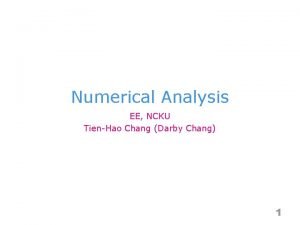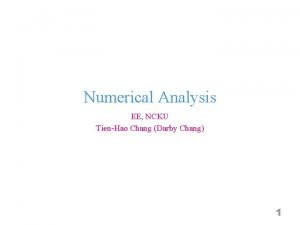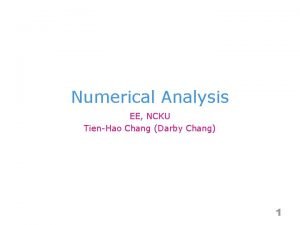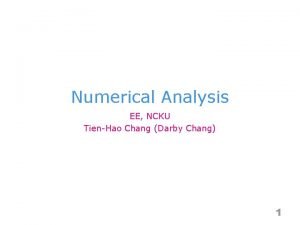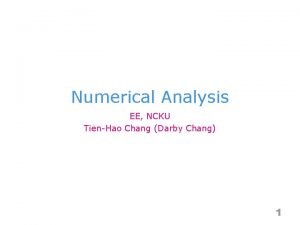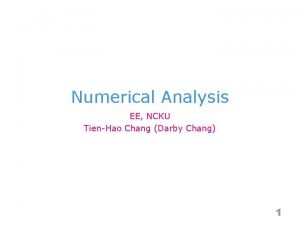Lecture 2 Ngram KaiWei Chang CS University of













































- Slides: 45

Lecture 2: N-gram Kai-Wei Chang CS @ University of Virginia kw@kwchang. net Couse webpage: http: //kwchang. net/teaching/NLP 16 CS 6501: Natural Language Processing 1

This lecture v Language Models v What are N-gram models? v How to use probabilities v What does P(Y|X) mean? v How can I manipulate it? v How can I estimate its value in practice? CS 6501: Natural Language Processing 2

What is a language model? v CS 6501: Natural Language Processing 3

Language model applications Context-sensitive spelling correction CS 6501: Natural Language Processing 4

Language model applications Autocomplete CS 6501: Natural Language Processing 5

Language model applications Smart Reply CS 6501: Natural Language Processing 6

Language model applications Language generation https: //pdos. csail. mit. edu/archive/scigen/ CS 6501: Natural Language Processing 7

Bag-of-Words with N-grams v N-grams: a contiguous sequence of n tokens from a given piece of text http: //recognize-speech. com/language-model/n-gram-model/comparison CS 6501: Natural Language Processing 8

N-Gram Models v CS 6501: Natural Language Processing 9

Random language via n-gram v http: //www. cs. jhu. edu/~jason/465/Power. Po int/lect 01, 3 tr-ngram-gen. pdf v Behind the scenes – probability theory CS 6501: Natural Language Processing 10

Sampling with replacement 1. P( ) = ? 2. P( ) = ? 3. P(red, ) = ? 4. P(blue) = ? 5. P(red | ) = ? 6. P( | red) = ? 7. P( ) = ? 8. P( ) = ? 9. P(2 x , 3 x , 4 x ) = ? CS 6501: Natural Language Processing 11

Sampling words with replacement Example from Julia hockenmaier, Intro to NLP CS 6501: Natural Language Processing 12

Implementation: how to sample? v CS 6501: Natural Language Processing 13

Conditional on the previous word Example from Julia hockenmaier, Intro to NLP CS 6501: Natural Language Processing 14

Conditional on the previous word Example from Julia hockenmaier, Intro to NLP CS 6501: Natural Language Processing 15

Recap: probability Theory v CS 6501: Natural Language Processing 16

The Chain Rule v CS 6501: Natural Language Processing 17

Language model for text v We need independence assumptions! Chain rule: from conditional probability to joint probability v 475, 000 main headwords in Webster's Third New International Dictionary v. Average English sentence length is 14. 3 words How large is this? CS 6501: Natural Language Processing 18

Probability models v Building a probability model: v defining the model (making independent assumption) v estimating the model’s parameters v use the model (making inference) Trigram Model (defined in terms of parameters like P(“is”|”today”) ) CS 6501: Natural Language Processing definition of P 19

Independent assumption v CS 6501: Natural Language Processing 20

Language model with N-gram v CS 6501: Natural Language Processing 21

Language model with N-gram v CS 6501: Natural Language Processing 22

Unigram model CS 6501: Natural Language Processing 23

Bigram model v Condition on the previous word CS 6501: Natural Language Processing 24

Ngram model CS 6501: Natural Language Processing 25

More examples v Yoav’s blog post: http: //nbviewer. jupyter. org/gist/yoavg/d 761 21 dfde 2618422139 v 10 -gram character-level LM: First Citizen: Nay, then, that was hers, It speaks against your other service: But since the youth of the circumstance be spoken: Your uncle and one Baptista's daughter. SEBASTIAN: Do I stand till the break off. BIRON: Hide thy head. CS 6501: Natural Language Processing 26

~~/* * linux/kernel/time. c * Please report this on hardware. */ void irq_mark_irq(unsigned long old_entries, eval); More examples v Yoav’s blog post: /* http: //nbviewer. jupyter. org/gist/yoavg/d 761 * Divide only 1000 for ns^2 -> us^2 conversion values don't overflow: 21 dfde 2618422139 seq_puts(m, "ttramp: %p. S", (void *)class->contending_point]++; if (likely(t->flags & WQ_UNBOUND)) { v 10 -gram character-level LM: /* * Update inode information. If the * slowpath and sleep time (abs or rel) * @rmtp: remaining (either due * to consume the state of ring buffer size. */ header_size - size, in bytes, of the chain. */ BUG_ON(!error); } while (cgrp) { if (old) { if (kdb_continue_catastrophic; #endif CS 6501: Natural Language Processing 27

Questions? CS 6501: Natural Language Processing 28

Maximum likelihood Estimation “Best” means “data likelihood reaches maximum” Unigram Language Model p(w| )=? 10/100 5/100 3/100 1/100 … text ? mining ? assocation ? database ? … query ? … Estimation Document text 10 mining 5 association 3 database 3 algorithm 2 … query 1 efficient 1 A paper (total #words=100) CS 6501: Natural Language Processing 29

v Which bag of words more likely generate: aaa. Daaa. Koaaaa a a o K a a D a E a a a P o K a D F b E n CS 6501: Natural Language Processing 30

Parameter estimation v CS 6501: Natural Language Processing 31

Maximum likelihood estimation v CS 6501: Natural Language Processing 32

Maximum likelihood estimation v Lagrange multiplier Since Set partial derivatives to zero we have Requirement from probability ML estimate CS 6501: Natural Language Processing 33

Maximum likelihood estimation v Length of document or total number of words in a corpus CS 6501: Natural Language Processing 34

A bi-gram example <S> I am Sam </S> <S> I am legend </S> <S> Sam I am </S> P( I | <S>) = ? P(am | I) = ? P( Sam | am) = ? P( </S> | Sam) = ? P( <S>I am Sam</S> | bigram model) = ? CS 6501: Natural Language Processing 35

Practical Issues v CS 6501: Natural Language Processing 36

More resources v Google n-gram: https: //research. googleblog. com/2006/08/allour-n-gram-are-belong-to-you. html File sizes: approx. 24 GB compressed (gzip'ed) text files Number Number of of tokens: 1, 024, 908, 267, 229 sentences: 95, 119, 665, 584 unigrams: 13, 588, 391 bigrams: 314, 843, 401 trigrams: 977, 069, 902 fourgrams: 1, 313, 818, 354 fivegrams: 1, 176, 470, 663 CS 6501: Natural Language Processing 37

More resources v Google n-gram viewer https: //books. google. com/ngrams/ Data: http: //storage. googleapis. com/books/ngrams/ books/datasetsv 2. html circumvallate 1978 335 91 circumvallate 1979 261 91 CS 6501: Natural Language Processing 38

CS 6501: Natural Language Processing 39

CS 6501: Natural Language Processing 40

CS 6501: Natural Language Processing 41

CS 6501: Natural Language Processing 42

How about unseen words/phrases v CS 6501: Natural Language Processing 43

Next Lecture v Dealing with unseen n-grams v Key idea: reserve some probability mass to events that don’t occur in the training data v How much probability mass should we reserve? CS 6501: Natural Language Processing 44

Recap v N-gram language models v How to generate text from a language model v How to estimate a language model v Reading: Speech and Language Processing Chapter 4: N-Grams CS 6501: Natural Language Processing 45
 Kai-wei chang
Kai-wei chang Kai wei chang
Kai wei chang Kaiwei chang
Kaiwei chang Google books ngram
Google books ngram Ngram
Ngram Ngram analyzer google
Ngram analyzer google Google books ngram viewer api
Google books ngram viewer api Ngram wikipedia
Ngram wikipedia 01:640:244 lecture notes - lecture 15: plat, idah, farad
01:640:244 lecture notes - lecture 15: plat, idah, farad Joe chang
Joe chang Tc chang
Tc chang Jichuan chang
Jichuan chang Darrick chang
Darrick chang Peter chang jewelry
Peter chang jewelry Fay chang google
Fay chang google Khởi nghĩa chàng lía nổ ra ở đâu
Khởi nghĩa chàng lía nổ ra ở đâu Xavier rival
Xavier rival Ching chang walla walla bing bang song
Ching chang walla walla bing bang song Chang pao chinese clothing
Chang pao chinese clothing Lpity
Lpity Paoti chang
Paoti chang Hee chang trading co. ltd
Hee chang trading co. ltd Winnie chang fiu
Winnie chang fiu Joo yeun chang
Joo yeun chang Chang wah technology
Chang wah technology Chang pui chung memorial school
Chang pui chung memorial school Thêu chăng chặn
Thêu chăng chặn Conclusion machine learning
Conclusion machine learning Angel x chang
Angel x chang Conrad chang
Conrad chang Rong chang dictation
Rong chang dictation Paoti chang
Paoti chang Chia hui chang
Chia hui chang Chẳng may em đánh vỡ một lọ hoa đẹp
Chẳng may em đánh vỡ một lọ hoa đẹp Trên đồng cỏ xanh rì người cho tôi nằm nghỉ
Trên đồng cỏ xanh rì người cho tôi nằm nghỉ Post classical vietnam
Post classical vietnam Chang'an
Chang'an Johan chang
Johan chang Chẳng nhìn thấy ve đâu
Chẳng nhìn thấy ve đâu Chang horing
Chang horing Language change theories
Language change theories Chia hui chang
Chia hui chang Jichuan chang
Jichuan chang Chemistry by raymond chang 10th edition
Chemistry by raymond chang 10th edition Chang cgi
Chang cgi Remco chang
Remco chang
